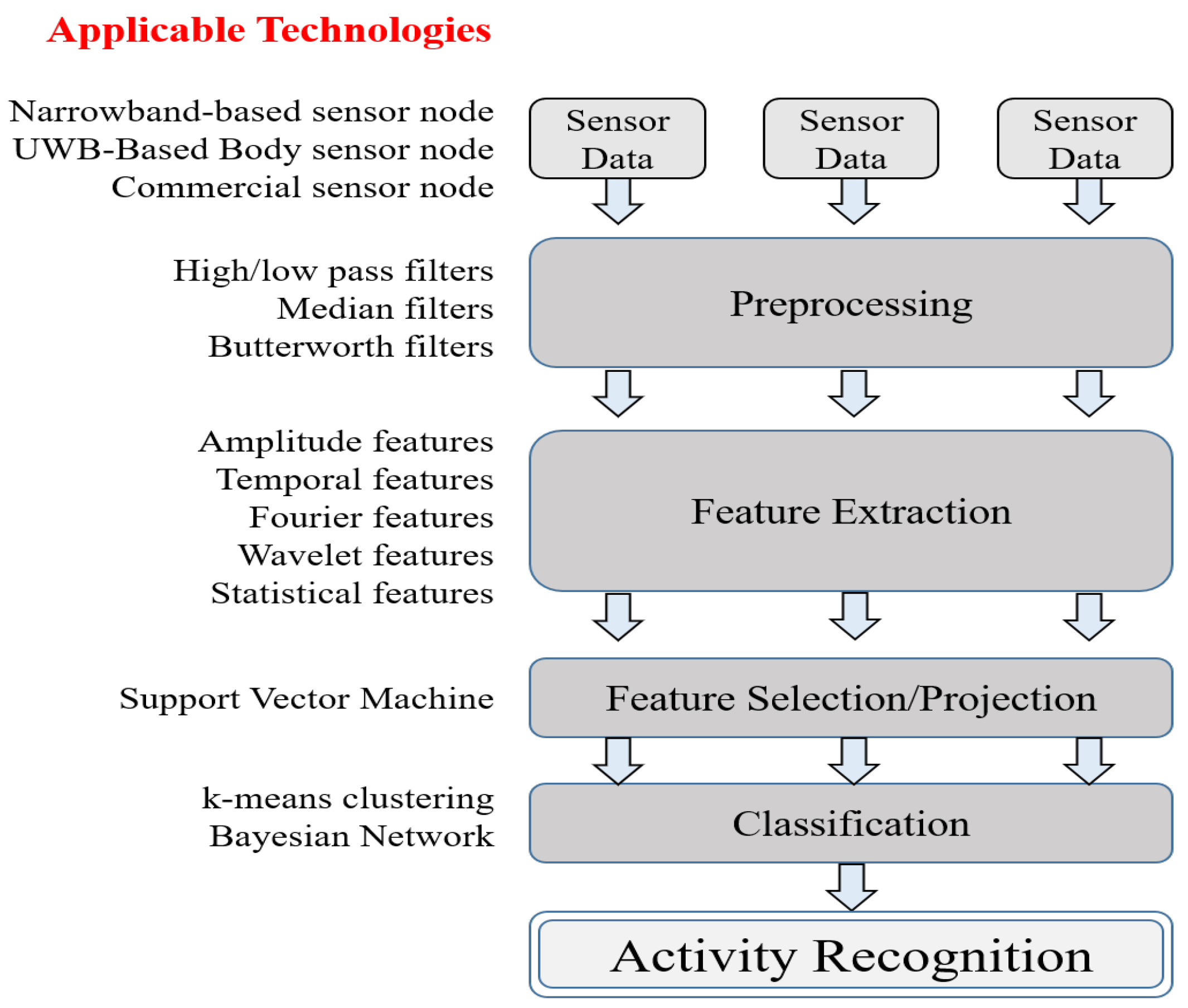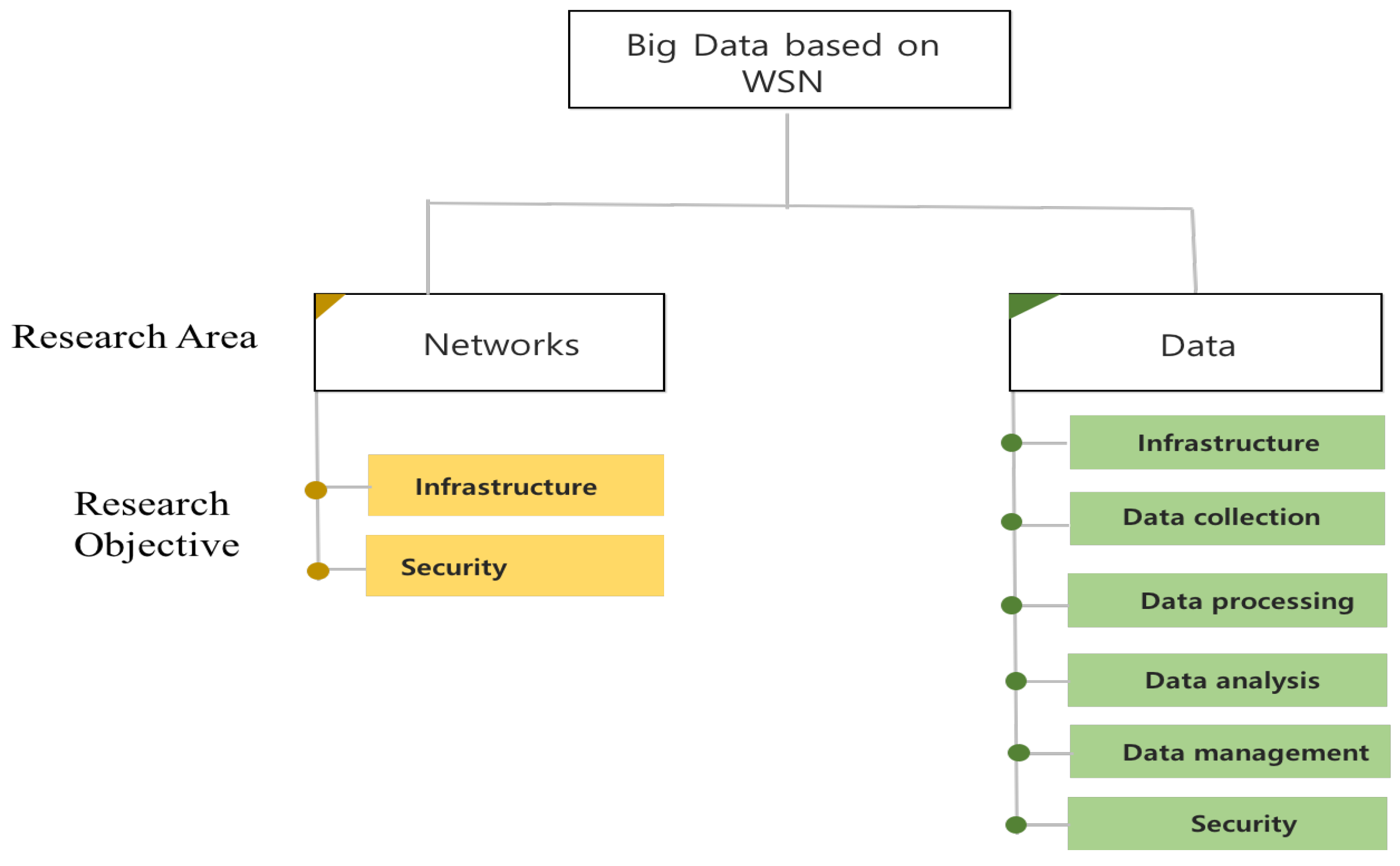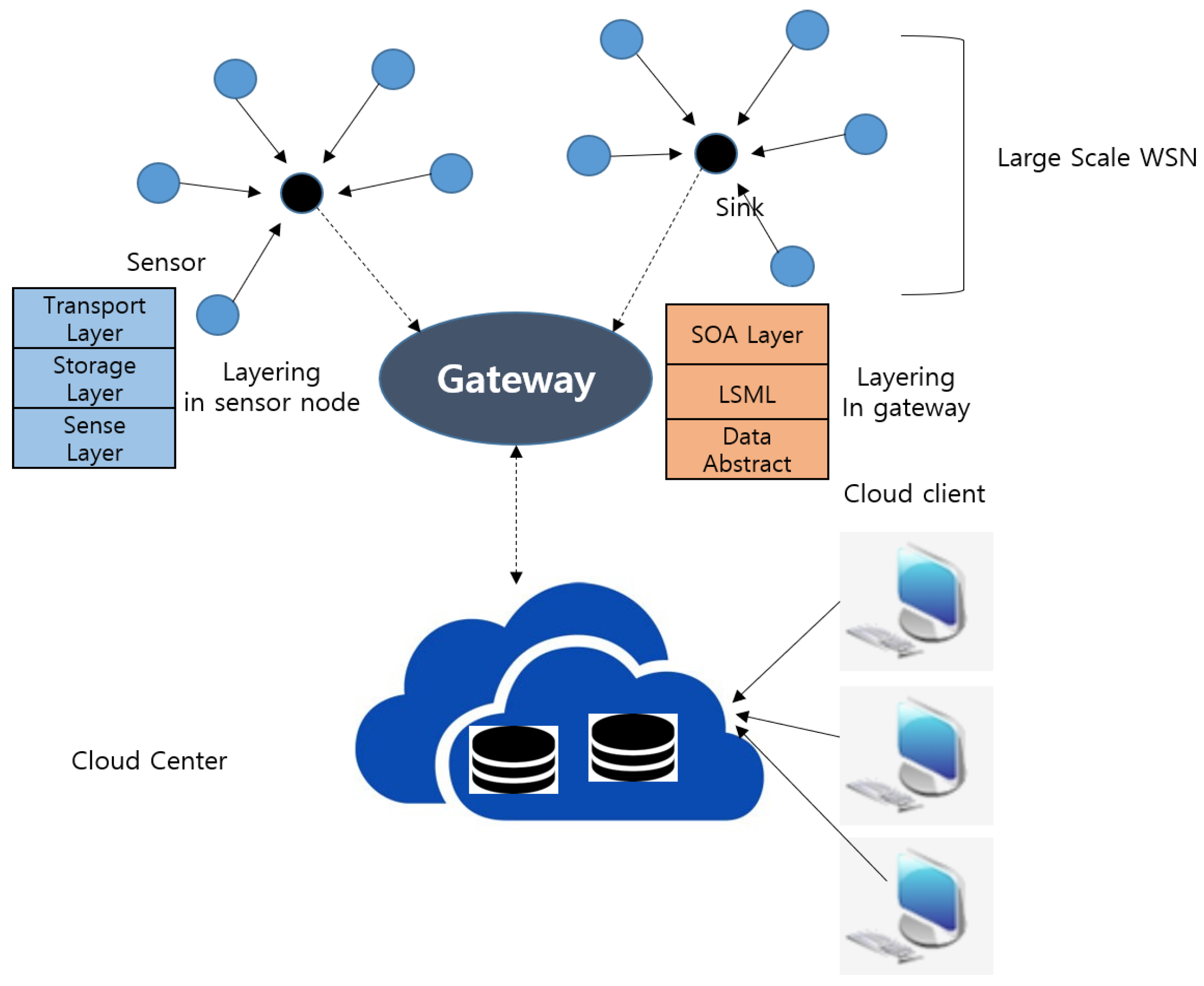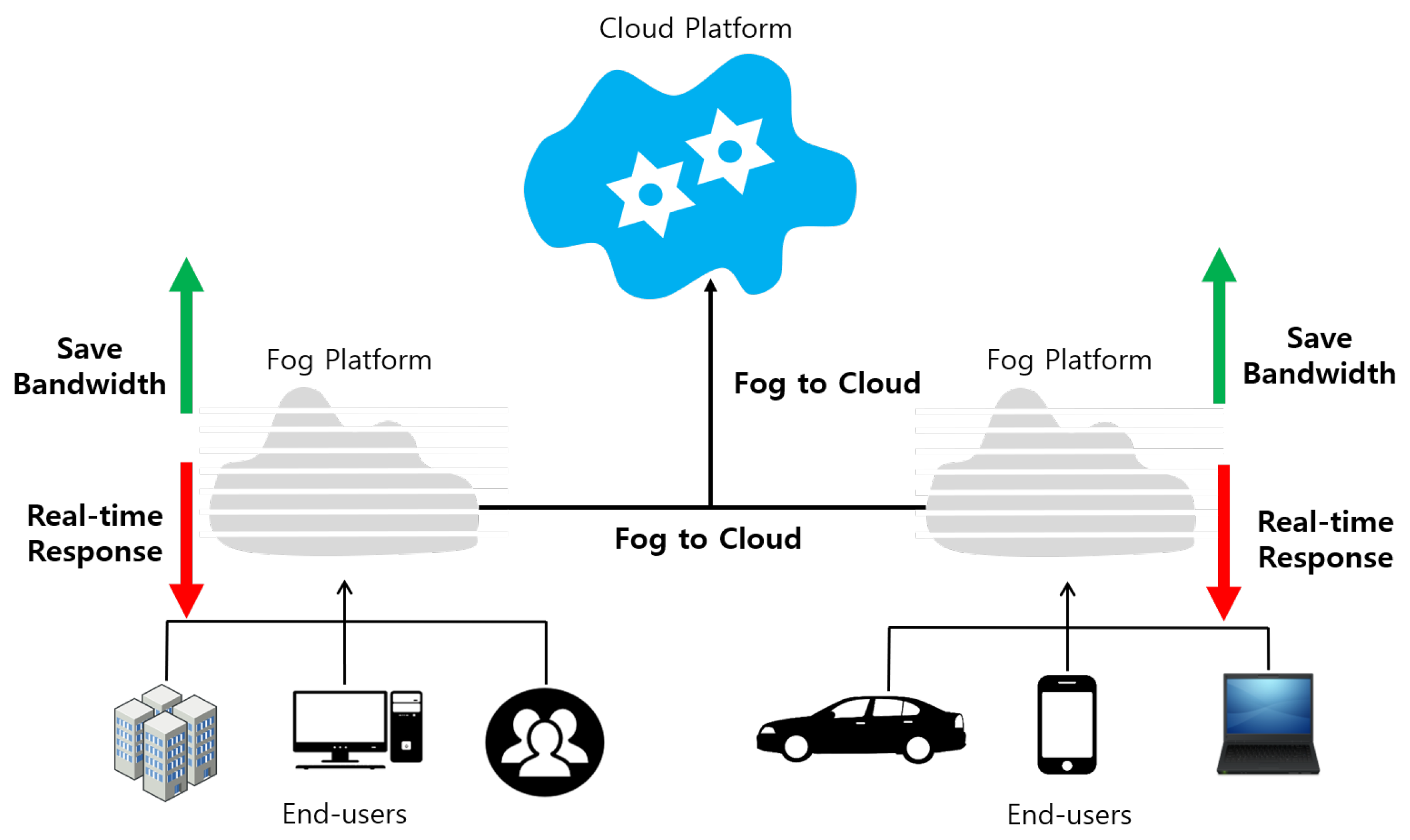Wireless Sensor Networks for Big Data Systems
Abstract
1. Introduction
2. Applications of WSN-Based Big Data Systems
3. Technical Approaches to WSN-Based Big Data Systems
3.1. Big Data Through WSN
3.2. Categorization
3.3. Network System
3.3.1. Infrastructure
3.3.2. Security
3.4. Data System
3.4.1. Infrastructure
3.4.2. Data Collection
3.4.3. Data Processing
3.4.4. Data Management
3.4.5. Data Analysis
3.4.6. Security
4. Open Issues
4.1. Evolution to Internet-of-Things (IoT)
4.2. Application-Specific Requirements
4.3. Network Architecture
4.4. Real-Time Communications on Fog Computing
4.5. Extensive and Flexible Framework
4.6. Modeling and Simulation
5. Conclusions
Author Contributions
Funding
Conflicts of Interest
References
- Chen, C.L.P.; Zhang, C. Data-intensive Applications, Challenges, Techniques and Technologies: A Survey on Big Data. Inf. Sci. 2014, 275, 314–347. [Google Scholar] [CrossRef]
- Chen, M.; Mao, S.; Liu, Y. Big Data: A Survey. Mob. Netw. Appl. 2014, 19, 171–209. [Google Scholar] [CrossRef]
- Oussous, A.; Benjelloun, F.; Lahcen, A.; Belfkiha, S. Big Data Technologies: A Survey. J. King Saud Univ. Comput. Inf. Sci. 2018, 30, 431–448. [Google Scholar] [CrossRef]
- Xiao, F.; Zhang, C.; Han, Z. Editorial: Big Data in Ubiquitous Wireless Sensor Networks. Int. J. Distrib. Sens. Netw. 2014. [Google Scholar] [CrossRef]
- Halde, S.; Khot, S. Big Data in Wireless Sensor Network: Issues & Challenges. Int. J. Adv. Eng. Manag. Sci. 2016, 2, 1618–1621. [Google Scholar]
- Harb, H.; Idrees, A.; Jaber, A.; Makhoul, A.; Zahwe, O.; Taam, M. Wireless Sensor Networks: A Big Data Source in Internet of Things. Int. J. Sens. Wirel. Commun. Control 2017, 7, 93–109. [Google Scholar] [CrossRef]
- Komalavalli, C. Convergence of Wireless Sensor Networks, Internet of Things, Big Data: Challenges. Int. J. Sci. Res. Eng. Technol. 2017, 6, 649–652. [Google Scholar]
- Sezer, O.; Dogdu, E.; Ozbayoglu, A. Context-Aware Computing, Learning, and Big Data in Internet of Things: A Survey. IEEE Internet Things J. 2018, 5, 1–27. [Google Scholar] [CrossRef]
- Qian, L.; Zhu, J.; Zhang, S. Survey of Wireless Big Data. J. Commun. Inf. Netw. 2017, 2, 1–18. [Google Scholar] [CrossRef]
- Jaradat, M.; Jarrah, M.; Bousselham, A.; Jararweh, Y.; Al-Ayyouba, M. The Internet of Energy: Smart Sensor Networks and Big Data Management for Smart Grid. Procedia Comput. Sci. 2015, 56, 592–597. [Google Scholar] [CrossRef]
- Jangili, S.; Bikshalu, K. Smart Grid Administration using Big Data and Wireless Sensor Networks. Int. J. Adv. Res. Sci. Eng. 2017, 6, 629–636. [Google Scholar]
- Poon, C.; Lo, B.; Yuce, M.; Alomainy, A.; Hao, Y. Body Sensor Networks: in the Era of Big Data and Beyond. IEEE Rev. Biomed. Eng. 2015, 8, 4–16. [Google Scholar] [CrossRef]
- Du, Y.; Hu, F.; Wang, L.; Wang, F. Framework and Challenges for Wireless Body Area Networks Based on Big Data. In Proceedings of the IEEE International Conference on Digital Signal Processing, Singapore, 21–24 July 2015. [Google Scholar]
- Yuan, H.; Wang, J.; An, Q.; Li, S. Research of WSN and Big Data Analysis Based Continuous Pulse Monitoring System for Efficient Physical Training. In Proceedings of the Future Technologies Conference, San Francisco, CA, USA, 6–7 December 2016. [Google Scholar]
- Wu, D.; Shi, H.; Wang, H.; Wang, R.; Fang, H. A Feature-based Learning System for Internet of Things Applications. IEEE Internet Things J. 2018. [Google Scholar] [CrossRef]
- Molka-Danielsen, J.; Engelseth, P.; Olesnanikova, V.; Sarafin, P.; Zalman, R. Big Data Analytics for Air Quality Monitoring at a Logistics Shipping Base via Autonomous Wireless Sensor Network Technologies. In Proceedings of the International Conference on Enterprise Systems, Beijing, China, 22–24 September 2017. [Google Scholar]
- Khaday, B.; Matson, E.; Springer, J.; Kwon, Y.; Kim, H.; Kim, S.; Kenzhebalin, D.; Cho, S.; Yoon, J.; Hong, S. Wireless Sensor Network and Big Data in Cooperative Fire Security system using HARMS. In Proceedings of the International Conference on Automation, Robotics and Applications, Queenstown, New Zealand, 17–19 February 2015. [Google Scholar]
- Gonzalez-Jaramillo, V. Tutorial: Internet of Things and The Upcoming Wireless Sensor Networks Related with The Use of Big Data in Mapping Services; Issues of Smart Cities. In Proceedings of the International Conference on eDemocracy & eGovernment, Sangolqui, Ecuador, 30 March–1 April 2016. [Google Scholar]
- Fouad, M.; Oweis, N.; Gaber, T.; Ahmed, M.; Snasel, V. Data Mining and Fusion Techniques for WSNs as a Source of the Big Data. Procedia Comput. Sci. 2015, 65, 778–786. [Google Scholar] [CrossRef]
- Boubiche, S.; Boubiche, D.; Bilami, A.; Toral-Cruz, H. Big Data Challenges and Data Aggregation Strategies in Wireless Sensor Networks. IEEE Access 2018, 6, 20558–20571. [Google Scholar] [CrossRef]
- Djedouboum, A.; Ari, A.; Gueroui, A.; Mohamadou, A.; Aliouat, Z. Big Data Collection in Large-Scale Wireless Sensor Networks. Sensors 2018, 18, 4474. [Google Scholar] [CrossRef]
- Rios, L.; Diguez, J. Big Data Infrastructure for Analyzing Data Generated by Wireless Sensor Networks. In Proceedings of the IEEE International Congress on Big Data, Anchorage, AK, USA, 27 June–2 July 2014; pp. 816–823. [Google Scholar]
- Song, C. A Novel Wireless Sensor Network Architecture Based on Cloud Computing and Big Data. Int. J. Online Eng. 2017, 13, 18–25. [Google Scholar] [CrossRef]
- Vijayalaxmi. An Efficient Way to Gather Big Data in WSN Using Mobile Sink Routing. In. J. Adv. Res. Comput. Commun. Eng. 2015, 4, 43–45. [Google Scholar]
- Kalnoor, G.; Agarkhed, J. Management of Big Data for Improving Performance of Wireless Sensor Network Using a Structured Clustering Approach. Int. J. Softw. Eng. Soft Comput. 2016, 6. [Google Scholar] [CrossRef]
- Ang, K.; Seng, J.; Zungeru, A. Optimizing Energy Consumption for Big Data Collection in Large-Scale Wireless Sensor Networks With Mobile Collectors. IEEE Syst. J. 2018, 12, 616–626. [Google Scholar] [CrossRef]
- Xu, Z. The Analytics and Applications on Supporting Big Data Framework in Wireless Surveillance Networks. Int. J. Soc. Humanist. Comput. 2017, 2, 141–149. [Google Scholar] [CrossRef]
- Akshatha, T.; Praveena, T. Data Aggregation in Wireless Sensor Network for Big Data. Int. J. Innov. Res. Comput. Commun. Eng. 2016, 4, 15292–15301. [Google Scholar]
- Wu, M.; Tan, L.; Xiong, N. A Structure Fidelity Approach for Big Data Collection in Wireless Sensor Networks. Sensors 2015, 15, 248–273. [Google Scholar] [CrossRef] [PubMed]
- Harb, H.; Makoul, A.; Jaoude, C. A Real-Time Massive Data Processing Technique for Densely Distributed Sensor Networks. IEEE Access 2018, 6, 56551–56561. [Google Scholar] [CrossRef]
- Reshma, J.; Kumar, T.; Vani, B.; Sakthivel, S. Big Data Oriented Energy Aware Routing for Wireless Sensor Networks. Mob. Netw. Appl. 2018, 1–9. [Google Scholar] [CrossRef]
- Zhou, Q.; Xiao, D.; Tang, Y.; Rong, C. Trusted Big Data Capture and Transport Architecture for Wireless Sensor Network. J. Internet Technol. 2014, 15, 1033–1041. [Google Scholar]
- Kandah, F.; Nichols, O.; Yang, L. Efficient Key Management for Big Data Gathering in Dynamic Sensor Networks. In Proceedings of the International Conference on Computing, Networking and Communications, Santa Clara, CA, USA, 26–29 January 2017. [Google Scholar]
- Boubiche, D. Secure and Efficient Big Data Gathering in Heterogeneous Wireless Sensor Networks. In Proceedings of the International Conference on Internet of Things And Cloud Computing, Cambridge, UK, 22–23 March 2016. [Google Scholar]
- Zhou, Q.; Xiao, D.; Tang, Y.; Rong, C. Energy-efficient Big Data Storage and Retrieval for Wireless Sensor Networks with Nonuniform Node Distribution. Concurr. Comput. Pract. Exp. 2015, 27, 5765–5779. [Google Scholar]
- Yoon, J. Three-Tiered Data Mining for Big Data Patterns of Wireless Sensor Networks in Medical and Healthcare Domains. In Proceedings of the 2013 International Conference on Internet and Web Applications and Services, Rome, Italy, 23–28 June 2013. [Google Scholar]
- Tracey, D.; Sreenan, C. A Holistic Architecture for the Internet of Things, Sensing Services and Big Data. In Proceedings of the IEEE/ACM International Symposium on Cluster, Cloud, and Grid Computing, Delft, The Netherlands, 13–16 May 2013. [Google Scholar]
- Jayaraman, P.; Zaslavsky, A.; Delsing, J. Cost Efficient Data Collection of Sensory Originated Data Using Context-Aware Mobile Devices. In Proceedings of the International Conference on Mobile Data Management Workshops, Beijing, China, 27–30 April 2008. [Google Scholar]
- Pattanshetti, A.; Kale, N. Big-data Gathering Using Mobile Collector in Densely Deployed Wireless Sensor Network. Int. J. Emerg. Trends Sci. Technol. 2015, 2, 5765–5779. [Google Scholar]
- Zhu, J.; Yin, X.; Bai, J.; Wang, Y. Mobility-assisted Big Data Collecting in Wireless Sensor Networks. Int. J. Distrib. Sens. Netw. 2016. [Google Scholar] [CrossRef]
- Suja, G.J.; Jose, S.; Raman, R.; Samuel, P. Performance Analysis of Big Data Gathering in Wireless Sensor Network Using an EM Based Clustering Scheme. In Proceedings of the International Conference on Advances in Computing and Communications, Kochi, India, 2–4 September 2015. [Google Scholar]
- Takaishi, D.; Nishiyama, H.; Kato, N.; Miura, R. Toward Energy Efficient Big Data Gathering in Densely Distributed Sensor Networks. IEEE Trans. Emerg. Top. Comput. 2014, 2, 388–397. [Google Scholar] [CrossRef]
- Sujithra, T.; Venkatesan, R. Swift and Energy Efficient Big Data Gathering Approaches in Wireless Sensor Networks. Int. J. Comput. App. 2016, 138, 14–19. [Google Scholar] [CrossRef]
- Rani, S.; Ahmed, S.; Talwar, R.; Malhotra, J. Can Sensors Collect Big Data? An Energy-Efficient Big Data Gathering Algorithm for a WSN. IEEE Trans. Ind. Inform. 2017, 13, 1961–1968. [Google Scholar] [CrossRef]
- Idrees, A.; Harb, H.; Jaber, A.; Zahwe, O.; Taam, M. Adaptive Distributed Energy-saving Data Gathering Technique for Wireless Sensor Networks. In Proceedings of the International Conference on Wireless and Mobile Computing, Networking and Communications, Rome, Italy, 9–11 October 2017. [Google Scholar]
- Ding, X.; Tian, Y.; Yu, Y. A Real-Time Big Data Gathering Algorithm Based on Indoor Wireless Sensor Networks for Risk Analysis of Industrial Operations. IEEE Trans. Ind. Inform. 2016, 12, 1232–1242. [Google Scholar] [CrossRef]
- Sun, Z.; Ji, X. HDAC High-Dimensional Data Aggregation Control Algorithm for Big Data in Wireless Sensor Networks. Int. J. Inf. Technol. Web Eng. 2017, 12, 72–86. [Google Scholar] [CrossRef]
- Hung, C.; Hsieh, C. Chapter 5: Big Data Management on Wireless Sensor Networks. In Big Data Analytics for Sensor-Network Collected Intelligence; Morgan Kaufmann: Burlington, MA, USA, 2017. [Google Scholar]
- Medlej, M. Big Data Management for Periodic Wireless Sensor Networks. Ph.D. Thesis, Universite de Franche-Comte, Besançon, France, 2014. [Google Scholar]
- Yang, C.; Liu, C.; Zhang, X.; Nepal, S.; Chen, J. A Time Efficient Approach for Detecting Errors in Big Sensor Data on Cloud. IEEE Trans. Parallel Distrib. Syst. 2015, 26, 329–339. [Google Scholar] [CrossRef]
- Kumar, A.; Ashok, M.; Sam, R. Error Detection and Cleaning for Big Data Sets from Sensor Network Systems on Cloud. Int. J. Comput. Sci. Trends Technol. 2016, 4, 261–265. [Google Scholar]
- Mohapatra, S.; Sahoo, P.; Wu, S. Big Data Analytic Architecture for Intruder Detection in Heterogeneous Wireless Sensor Networks. J. Netw. Comput. Appl. 2016, 66, 236–249. [Google Scholar] [CrossRef]
- Kucukkecesi, C.; Yazici, A. Big Data Model Simulation on a Graph Database for Surveillance in Wireless Multimedia Sensor Networks. Big Data Res. 2018, 11, 33–43. [Google Scholar] [CrossRef]
- Meng, W.; Li, W.; Su, C.; Zhou, J.; Lu, R. Enhancing Trust Management for Wireless Intrusion Detection via Traffic Sampling in the Era of Big Data. IEEE Access 2018, 6, 7234–7243. [Google Scholar] [CrossRef]
- Zhu, C.; Shu, L.; Leung, V.; Guo, S.; Zhang, Y.; Yang, L. Secure Multimedia Big Data in Trust-Assisted Sensor-Cloud for Smart City. IEEE Commun. Mag. 2017, 55, 24–30. [Google Scholar] [CrossRef]
- Wu, D.; Si, S.; Wu, S.; Wang, R. Dynamic Trust Relationships Aware Data Privacy Protection in Mobile Crowd-Sensing. IEEE Internet Things J. 2017, 5, 2958–2970. [Google Scholar] [CrossRef]
- Kuo, Y.; Li, C.; Jhang, J.; Lin, S. Design of a Wireless Sensor Network-Based IoT Platform for Wide Area and Heterogeneous Applications. IEEE Sens. J. 2018, 18, 5187–5197. [Google Scholar] [CrossRef]
- Morillo, P.; Orduña, J.; Fernández, M.; García-Pereira, I. Comparison of WSN and IoT Approaches for A Real-time Monitoring System of Meal Distribution Trolleys: A Case Study. Future Gener. Comput. Syst. 2018, 87, 242–250. [Google Scholar] [CrossRef]
- Marjani, M.; Nasaruddin, F.; Gani, A.; Karim, A.; Hashem, I.; Siddiqa, A.; Yaqoob, I. Big IoT Data Analytics: Architecture, Opportunities, and Open Research Challenges. IEEE Access 2017, 5, 5247–5261. [Google Scholar]
- Morillo, P.; M.Orduña, J.; Fernández, M.; García-Pereira, I. Big-Sensing-Data Curation for the Cloud Is Coming: A Promise of Scalable Cloud-Data-Center Mitigation for Next-Generation IoT and Wireless Sensor Networks. IEEE Consum. Electron. Mag. 2017, 6, 48–56. [Google Scholar]
- Gupta, N.; Gupta, V. A Review on Sink Mobility Aware Fast and Efficient Data Gathering in Wireless Sensor Networks. In Proceedings of the International Conference on Advances in Computing, Communication & Automation, Dehradun, India, 8–9 April 2016. [Google Scholar]
- Mazumdar, N.; Roy, S.; Nayak, S. A Survey on Clustering Approaches for Wireless Sensor Networks. In Proceedings of the International Conference on Data Science and Business Analytics, Porto, Portugal, 26–28 July 2018; pp. 236–240. [Google Scholar]
- Li, J.; Guo, S.; Y, Y.; He, J. Data Aggregation with Principal Component Analysis in Big Data Wireless Sensor Networks. In Proceedings of the International Conference on Mobile Ad-Hoc and Sensor Networks, Hefei, China, 16–18 December 2016; pp. 45–51. [Google Scholar]
- Yu, T.; Wang, X.; Shami, A. Recursive Principal Component Analysis-based Data Outlier Detection and Sensor Data Aggregation in IoT Systems. IEEE Internet Things J. 2017, 4, 2207–2216. [Google Scholar] [CrossRef]
- Yue, Y.; Fan, H.; Li, J.; Qin, Q. Large-scale Mobile Wireless Sensor Network Data Fusion Algorithm. In Proceedings of the IEEE International Conference on Big Data Analysis, Hangzhou, China, 12–14 March 2016. [Google Scholar]
- Hu, P.; Dhelim, S.; Ning, H.; Qiud, T. Survey on Fog Computing: Architecture, Key Technologies, Applications and Open Issues. J. Netw. Comput. Appl. 2017, 98, 27–42. [Google Scholar] [CrossRef]
- Kim, B.; Park, H.; Kim, K.; Godfrey, D.; Kim, K. A Survey on Real-Time Communications in Wireless Sensor Networks. Wirel. Commun. Mob. Comput. 2017, 2017, 1864847. [Google Scholar] [CrossRef]
- Khalid, Z.; Fisal, N.; Rozaini, M. A Survey of Middleware for Sensor and Network Virtualization. Sensors 2014, 14, 24046–24097. [Google Scholar] [CrossRef]






| Method | Key Feature | Advantage | Disadvantage |
|---|---|---|---|
| SWV4WSN [17] | Multi-layer model | Good lifecycle | High management cost |
| [18] | K-medoid clustering | High energy efficiency | High maintenance cost |
| [20] | Mobile sinks | Good for network partition | High energy consumption in few clusters |
| [21] | QoS provisioning | Balanced energy consumption | High complexity |
| [22] | Name and in-network caching | High energy efficiency | Low energy consumption in many clusters |
| [23] | Spatial correlation | High energy efficiency | No consideration for temporal correlation |
| Method | Key Feature | Advantage | Disadvantage |
|---|---|---|---|
| [28] | Framework based on Hadoop and Storm | Open-source based implementation | Low reliability |
| [29] | Distributed data-centric storage | High energy efficiency | Deployment issues in real-world scenarios |
| [30] | Three-tier data mining | Urgent response | Experiments in few scenarios |
| Method | Key Feature | Advantage | Disadvantage |
|---|---|---|---|
| CADAMULE [32] | Situation and event awareness | Cost-efficient data collection | Simple weight based computation |
| [33] | M-mobile collector | High energy efficiency | Few scenarios for simulation |
| [34] | MDCP | High energy efficiency | Assumption of infinite storage memory |
| [36] | Mobile collector | High energy efficiency | Flooding based operation |
| [37] | Local data collector | Reduced data-gathering latency | Too much dependency on threshold value |
| Research Area | Current Research Challenges | Further Trends |
|---|---|---|
| Networks Architecture | Static/mobile sink, aggregation | Energy efficiency, Specific protocols for applications, 5G Communications |
| Framework | Single platform for WSN | Integrated platform for M2M, P2P, and IoT |
| Real-time | QoS protocol | Fog/Edge computing, Middleware |
© 2019 by the authors. Licensee MDPI, Basel, Switzerland. This article is an open access article distributed under the terms and conditions of the Creative Commons Attribution (CC BY) license (http://creativecommons.org/licenses/by/4.0/).
Share and Cite
Kim, B.-S.; Kim, K.-I.; Shah, B.; Chow, F.; Kim, K.H. Wireless Sensor Networks for Big Data Systems. Sensors 2019, 19, 1565. https://doi.org/10.3390/s19071565
Kim B-S, Kim K-I, Shah B, Chow F, Kim KH. Wireless Sensor Networks for Big Data Systems. Sensors. 2019; 19(7):1565. https://doi.org/10.3390/s19071565
Chicago/Turabian StyleKim, Beom-Su, Ki-Il Kim, Babar Shah, Francis Chow, and Kyong Hoon Kim. 2019. "Wireless Sensor Networks for Big Data Systems" Sensors 19, no. 7: 1565. https://doi.org/10.3390/s19071565
APA StyleKim, B.-S., Kim, K.-I., Shah, B., Chow, F., & Kim, K. H. (2019). Wireless Sensor Networks for Big Data Systems. Sensors, 19(7), 1565. https://doi.org/10.3390/s19071565





